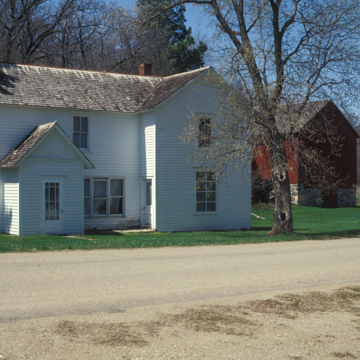The T. J. Walker Historic District is a complex of structures associated with pioneer miller and merchant Tyler James Walker. These buildings include the remains of a mill and adjacent dam, a 1953 dam, a store, a house, a large barn, and an ice storage building. The timber-frame Walker Mill is the only remaining water-driven mill in North Dakota of an estimated twenty that were built in the state between 1875 and 1900.
The Walker house is a two-story T-plan, gabled wood-frame building with Queen Anne elements. The house’s gable end includes a two-story semi-hexagonal bay window with diagonal siding that contrasts with the horizontal lap siding. Wooden pendants adorn the eaves of the hipped-roof window bay, surmounted by a sunrise motif in radiating lap siding that fills the gabled end. The gabled two-story bank barn is built into the hillside north of the house. Its lower walls are of quarry-faced fieldstone and the upper level is one of the few North Dakota barns built of heavy wood beams with mortise-and-tenon joints fixed with wooden pegs. A cupola with a bellcast finial ventilates the warm, moist air. Nearby are two related significant buildings: Standing Rock Lutheran Church (c. 1890) and Fort Ransom (c. 1915) rural school, which is attributed to Hancock Brothers.















